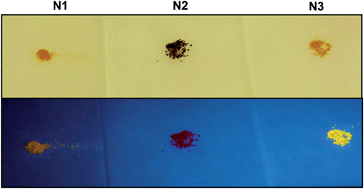Novel self-assembled 2D networks based on zinc metal ion co-ordination: synthesis and comparative study with 3D networks†
Abstract
The synthesis of linear and trigonal terpyridine bearing molecules (tpys) and their self-assembly to form novel extended self-assembled 2D networks of trigonal tpys with linear tpys through zinc metal ion (Zn2+) co-ordination is reported. The resulting Zn2+ co-ordination networks have been characterized by means of X-ray photoelectron spectroscopy (XPS), small angle X-ray scattering (SAXS), BET, and photophysical methods. The presence of some short range order in these networks has been shown by the SAXS results and these results have been analyzed with the help of molecular modelling studies. These metallo-supramolecular Zn2+ networks revealed the influence of the metal ion on the thermal and optical properties of the synthesized metallo-supramolecular assemblies, similar to the results previously reported for 1D and 3D self-assembled metallo-supramolecular materials. Moreover, these networks have shown high luminescence with a long fluorescence lifetime and good thermal stabilities. The monolayer of such ordered networks can be used as a template to build hierarchical nanostructures. These hierarchical nanostructures could be used as active components in electronic devices and as templates for the formation of hybrid organic–inorganic nanomaterials.


 Please wait while we load your content...
Please wait while we load your content...